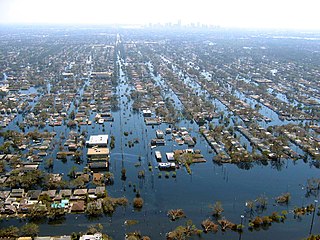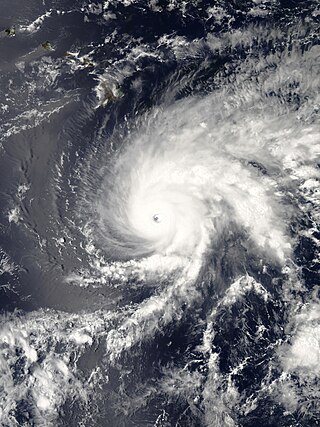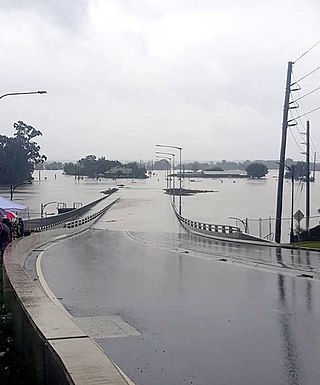| Date | March 7 – 15, 2021 |
|---|---|
| Location | All of Hawaii |
| Deaths | Unknown number killed, 1 missing [1] |
| Property damage | $49 million [2] |
The March 2021 Hawaii floods was a devastating series of floods that caused a tremendous amount of damage to the U.S state of Hawaii. [1] The heavy rain started on March 7, 2021, and flooded the Kaupakalua Dam. [3] It was reported that the dam flooded due to deficiencies, and as a result, it is set to be decommissioned this summer. [4] One person is currently missing from the floods, and at least a half dozen homes were heavily damaged or destroyed in the flooding, which also destroyed Peahi Bridge and heavily damaged Kaupakalua Bridge. [1] More than 1,300 customers in Haiku were without power at 6:30 a.m. Tuesday HST. [1]
A strong low-pressure system fed by abundant moisture from the tropics fueled slow-moving storms that dropped inches of rain per hour in certain areas. [5] Extremely heavy rains came down on Hawaii starting March 7, and overflowed the Kaupakalua Dam. [3] More than 7.5 inches of rain fell in Haiku in the 24 hours ending at 8:45 a.m. March 10, according to the National Weather Service. More than 16 inches of rain fell near Keanae about 7 miles away in western Maui. [1] The floodwaters from the overflowing dam and the heavy rain caused other rivers and streams to overflow, adding to the problem.
Due to the scale of the floods, the Governor of Hawaii, David Ige, declared a state of emergency and ordered evacuations all over the state. [6] [7] Flash Flood Warnings, watches, and advisories were also issued by the National Weather Service (NWS). [8] At least a half dozen homes were heavily damaged or destroyed in the flooding, which also destroyed Peahi Bridge, Hanalei Bridge, and heavily damaged Kaupakalua Bridge, and 1 person, carried away by floodwaters, is missing. Overtopping of the dam has now stopped, but the water level remains about 3 feet below the top of the dam. [1] [9] All Maui island parks were closed because of flooding and heavy rains. [10] The Hana highway was also temporarily closed as it was overwhelmed by floodwaters. [11] Nearly 4000 residents of the Haleiwa town were asked to evacuate. [12] The Waiahole Stream, located above the Kamehameha Highway, reported flow rates of nearly 9,000 cubic feet per second. The previous record, obtained through 19 years of maintaining data, was set in 2012 and was 432 cubic feet per second. The typical flow is around 90 cubic feet per second — just 1 percent of what was observed on March 9. [12] 8,200 gallons of partially treated wastewater had spilled within the grounds of a local wastewater treatment plant and partly on the grounds of the James Campbell National Wildlife Refuge. [13] Honolulu firefighters on Tuesday rescued a 27-year-old man after his truck was swept down a stream. He was found standing on the truck's roof. On Wednesday, they suspended another search for an individual a witness saw in a stream in Pearl City. [14] A major landslide occurred on March 11 near the Hanalei Hill, closing both lanes leading up to Hanalei Bridge. [15] A lightning storm left over 20,000 people without power in Kahala, Kapahulu, Palolo, Waikiki, Manoa, and Moiliili, [16] but the power was restored a few hours later. [17] Due to more heavy rain, the Kalihi stream began rising. [16] In response to the rising floodwaters, Kamehameha Highway was closed in both directions near Kualoa Regional Park. [16] Kamehameha Highway at the Waikane Bridge was also temporarily closed in both directions due to flooding, but was reopened an hour later. [16] Kuhio Highway was scheduled to be closed until March 15 due to a major landslide. [18] Kuhio Highway was the only road leading to the north shore. [18] There was a scheduled outage on Saturday, March 13, so that crews can complete repair work related to an outage that happened on Thursday, March 11. [19] In addition to the scheduled outage, the Department of Water (DOW) has issued a water conservation request for Hanalei customers on Saturday, March 13. [19]
Following the heavy rains and floods on Oahu, the Salvation Army scheduled outreach events in Haleiwa and Hauula to help impacted residents. [20] Eligible residents received disaster financial assistance, temporary housing assistance for those displaced by flooding, food, water and emotional and spiritual care. [20]

In October 2005, remnants of Tropical Storm Tammy and Subtropical Depression Twenty-Two merged with incoming continental cold fronts to produce torrential rains over interior New England, as well as over parts of New Jersey and New York. Particularly hard hit was the state of New Hampshire, which saw roads and bridges wiped out, several reported deaths, and whole buildings destroyed. Rain lingered over some areas for several weeks. Rainfall from both rain events totaled well over 20 inches (510 mm) in some areas.

Tropical Storm Claudette was a 1979 tropical cyclone which was the third-wettest tropical cyclone on record in the contiguous United States. The storm caused significant flooding in eastern Texas and western Louisiana in July 1979. The eighth tropical cyclone and third named storm of the 1979 Atlantic hurricane season, Claudette developed from a tropical wave located east of the Windward Islands on July 16. It gradually strengthened and was upgraded to a tropical storm on July 17 and crossed the northern Leeward Islands later that day. As it neared landfall in Puerto Rico early on July 18, upper-level winds weakened it back to a tropical depression. Claudette remained disorganized and the National Hurricane Center operationally reported that it degenerated back into a tropical wave after crossing Puerto Rico. Late on July 18, the depression struck Dominican Republic, emerged into the Caribbean Sea on the following day. Claudette struck western Cuba on July 21, shortly before reaching the Gulf of Mexico and "regenerating" into a tropical cyclone. By July 23, Claudette regained tropical storm intensity and turned northward toward the Gulf Coast of the United States. The storm made landfall near the Texas-Louisiana border late on July 23 as a moderately strong tropical storm. It weakened slowly and drifted over land, lasting until dissipation in West Virginia on July 29.
Hurricane Nina was the final tropical storm and hurricane of the 1957 Pacific hurricane season and the last storm to form during the active Central Pacific hurricane season this year. This storm was named "Nina" because during this time, hurricanes in this basin were given names from the typhoon naming lists. This storm was the last to form during a series of typhoons to form in the Pacific in November.

Floods in the United States (2000–present) is a list of flood events which were of significant impact to the country during the 21st century, since 2000. Floods are generally caused by excessive rainfall, excessive snowmelt, storm surge from hurricanes, and dam failure.

In October 1999, severe flooding affected portions of eastern Mexico and Central America. Rainfall in September preceded the primary event in Mexico, which moistened soils. On October 4, Tropical Depression Eleven developed in the Gulf of Mexico, which drew humidity from the gulf and the Pacific Ocean to produce torrential rainfall in mountainous regions of eastern Mexico, reaching 43.23 in (1,098 mm) in Jalacingo, Veracruz. This was the third-highest tropical cyclone-related rainfall total in Mexico from 1980–2006, and the event caused the highest rainfall related to tropical cyclones in Veracruz, Hidalgo, and Puebla. In some locations, the daily rainfall represented over 10% of the annual precipitation total. The heaviest rainfall occurred in mountainous regions that were the mouths of several rivers. A broad trough absorbed the depression on October 6, and rainfall continued for the next few days. Additional rainfall occurred in Tabasco state on October 18. The floods were estimated as a 1 in 67 year event in one location, although such floods are expected to affect eastern Mexico twice per century, the last time being 1944.

Hurricane Darby was the first Eastern Pacific major hurricane since Hurricane Kenna in 2002. The sixth tropical cyclone, fourth named storm, and second hurricane of the 2004 Pacific hurricane season, Darby developed from a tropical wave that emerged from the west coast of Africa on July 12. After crossing into the Eastern Pacific, the storm became a tropical depression on June 26. The system steadily intensified, and became a hurricane on 000 UTC July 28. Darby peaked as a Category 3 hurricane on the Saffir-Simpson Hurricane Scale, though it quickly deteriorated due to cooler waters and increasing wind shear. While Darby dissipated on August 1, the remnants of the tropical cyclone affected the Hawaiian Islands. The system produced high waves and heavy rainfall that led to extensive flash flooding. Numerous roads were closed, while minor landslides and rockslides were reported. Despite the effects, no fatalities or severe damages occurred.

Typhoon Parma, known in the Philippines as Typhoon Pepeng, was the second typhoon to affect the Philippines within the span of a week during September 2009.

The 2010 China floods began in early May 2010. Three hundred and ninety-two people died, and a further 232 people were reported missing as of June 30, 2010, including 57 people in a landslide in Guizhou. Fifty-three of the deaths occurred from the flooding and landslides between May 31 and June 3, and 266 deaths occurred between June 13 and June 29. Four hundred and twenty four people were killed by the end of June, including 42 from the Guizhou landslide; 277 more were killed and 147 were missing in the first two weeks of July, bringing the death toll as of August 5 to 1,072. A landslide in early August in Gansu killed at least 1,471 people and left 294 missing. In total, the flooding and landslides killed at least 3,185 people in China by August 31. More than 230 million people in 28 provinces, municipalities, and regions, especially the southern and central provinces and regions of Zhejiang, Fujian, Jiangxi, Hubei, Hunan, Guangdong, Guangxi, Chongqing Municipality, Gansu, Sichuan, and Guizhou, and the northeastern province of Jilin were affected, while at least 4.66 million people were evacuated because of the risk of flooding and landslides in the latter half of June. By early August, over 12 million people were evacuated, and that number rose to 15.2 million by August 31.
The 2010 Victorian floods were a widespread series of flood events across the state of Victoria, Australia. The floods, which followed heavy rain across southeastern Australia in early September 2010, caused the inundation of about 250 homes, hundreds of evacuations and millions of dollars of damage. Weather warnings were initially issued for Victoria on Thursday 2 September and rain began to fall on the Friday, continuing through the weekend to Tuesday. Heavy rain fell in most regions of the state, particularly at higher altitudes in the state's west and northeast, flooding the upper reaches of many of Victoria's major rivers. A state of emergency was declared with State Emergency Service crews arriving from Queensland, South Australia and Tasmania. The floods proceeded an extensive drought period that had effected the entirety of Australia.

Tropical Storm Flossie yielded stormy weather to Hawaii in late July 2013. The sixth tropical cyclone and named storm of the annual hurricane season, Flossie originated from a tropical wave that emerged off the western coast of Africa on July 9. Tracking westward across the Atlantic with little development, it passed over Central America and into the eastern Pacific Ocean on July 18, where favorable environmental conditions promoted steady organization. By 0600 UTC on July 25, the wave acquired enough organization to be deemed a tropical depression; it intensified into a tropical storm six hours later. Continuing westward, Flossie attained peak winds of 70 mph (110 km/h) on July 27 before entering the central Pacific Ocean. There, unfavorable upper-level winds established a weakening trend; on July 30, Flossie weakened to a tropical depression, and by 1200 UTC that same day, the storm degenerated into a remnant low, northeast of Kauai.

In April 2018, a series of thunderstorms produced record-breaking rainfall on the Hawaiian Islands of Kauaʻi and Oahu. An upper-level low moved across the area on April 13, generating a mesoscale convective system that moved over eastern Oahu, producing localized heavy rainfall that reached 5.55 in (141 mm). The heaviest rainfall occurred on northern Kauaʻi. There, a rain gauge owned by the Waipā Foundation, just west of Hanalei, recorded 49.69 in (1,262 mm) of rainfall in the 24 hours between 12:45 p.m. on April 14 and 15. This was the greatest 24-hour rainfall total on record in the United States, surpassing the previous record of 43 in (1,100 mm) in Alvin, Texas on July 25–26, 1979, set during Tropical Storm Claudette. Through the entire event, the same gauge recorded a total of 54.37 in (1,381 mm) of rain.

Hurricane Lane was a powerful tropical cyclone that brought torrential rainfall and strong winds to Hawaii during late August 2018. The storm was the wettest on record in Hawaii, with peak rainfall accumulations of 58 inches (1,473 mm) along the eastern slopes of Mauna Loa. The twelfth named storm, sixth hurricane, fourth major hurricane, and the first of three Category 5 hurricanes of the record-breaking 2018 Pacific hurricane season, Lane originated from an area of low pressure that formed well southwest of Mexico on August 13. Tracking west through a region of favorable atmospheric and oceanic conditions, the system steadily intensified over the following days. It reached an initial peak as a Category 4 hurricane on August 18. Temporarily inhibited by more hostile conditions, the hurricane weakened slightly before regaining strength and reaching Category 5 status on August 22 to the south of Hawaii. Lane peaked with winds of 160 mph (255 km/h) and a barometric pressure of 926 mbar. Thereafter, the hurricane turned north and slowed. During this period, torrential rains battered much of the Hawaiian Islands. Unfavorable conditions again affected the hurricane, and it degraded to a tropical depression by August 28 before dissipating the following day.

Hurricane Olivia was a Category 4 hurricane that impacted Hawaii as a weakening tropical storm in mid-September 2018, causing severe flooding and wind damage. Olivia was the first tropical cyclone to make landfall on Maui and Lanai in recorded history. It was the fifteenth named storm, ninth hurricane, and sixth major hurricane of the 2018 Pacific hurricane season.

Potential Tropical Cyclone Seventeen-E was a tropical disturbance that caused damaging floods in Southern Mexico, Guatemala, and El Salvador in mid-October 2019. A tropical wave entered the Eastern Pacific Ocean during October 13–14, and a low-pressure area developed by October 14 to the west of Nicaragua. Convection, also known as thunderstorm activity, associated with the system increased in both intensity and extent during October 15, while the system was south of Guatemala. The National Hurricane Center initiated advisories on the system as Potential Tropical Cyclone Seventeen-E on October 16, anticipating that the system would become a tropical cyclone before reaching the southern coast of Mexico. During its existence as a potential tropical cyclone, Seventeen-E had winds of 35 mph (55 km/h) and a pressure of 1,005 mbar (29.68 inHg). As the storm tracked northwestward towards the coast, its structure decayed, and the chance of tropical cyclogenesis decreased markedly. The disturbance made landfall between Bahias de Huatulco and Salina Cruz, Oaxaca, during mid-day October 16 and dissipated a few hours later.

Extreme rainfall on the east coast of Australia beginning on 18 March 2021 led to widespread flooding in New South Wales, affecting regions from the North Coast to the Sydney metropolitan area in the south. Suburbs of Sydney experienced the worst flooding in 60 years, and the events were described by NSW Premier Gladys Berejiklian as "one in 100-year" flooding. Far-southeast communities in Queensland were also affected by flooding and heavy rainfall, though to a lesser extent than those in New South Wales.

In July 2021, several European countries were affected by severe floods. Some were catastrophic, causing deaths and widespread damage. The floods started in the United Kingdom as flash floods causing some property damage and inconvenience. Later floods affected several river basins across Europe including Austria, Belgium, Croatia, Germany, Italy, Luxembourg, the Netherlands, and Switzerland. At least 243 people died in the floods, including 196 in Germany, 43 in Belgium, two in Romania, one in Italy and one in Austria.

The 2022 eastern Australia floods were one of the nation's worst recorded flood disasters with a series of floods that occurred from February to April in South East Queensland, the Wide Bay–Burnett and parts of coastal New South Wales. Brisbane suffered major flooding, along with the cities of Maryborough, Gympie, the Sunshine Coast, Caboolture, Toowoomba, Gatton, Ipswich, Logan City, the Gold Coast, Murwillumbah, Mullumbimby, Grafton, Byron Bay, Ballina, Lismore, the Central Coast and parts of Sydney.

Cyclone Dovi was a powerful tropical cyclone across the Southern Pacific in February 2022. The system became the third named tropical cyclone of the 2021–22 South Pacific cyclone season. The storm first formed in the Australian basin on February 4 before crossing over into the South Pacific. The storm caused one death in New Caledonia, and several mudslides occurred in New Caledonia and Vanuatu. Dovi also caused flight cancellations and damage out of New Zealand.